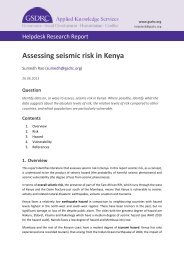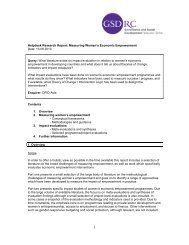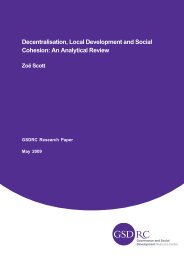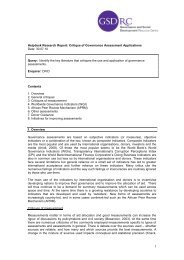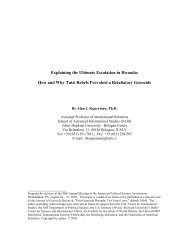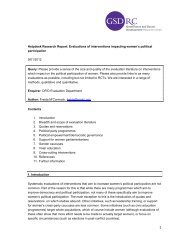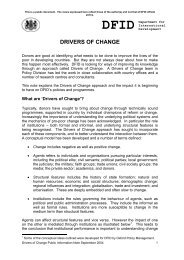Helpdesk Research Report: Performance Related Pay ... - GSDRC
Helpdesk Research Report: Performance Related Pay ... - GSDRC
Helpdesk Research Report: Performance Related Pay ... - GSDRC
Create successful ePaper yourself
Turn your PDF publications into a flip-book with our unique Google optimized e-Paper software.
<strong>Helpdesk</strong> <strong>Research</strong> <strong>Report</strong>: <strong>Performance</strong> <strong>Related</strong> <strong>Pay</strong>Date: 05.03.2010Query: Please identify recent resources and lessons learned on the introduction ofperformance-based pay in central government administrations in developing countries.Enquirer: DFID Burundi.Contents1. Overview2. <strong>Performance</strong> related pay in developing countries3. Developed country experience4. <strong>Performance</strong> based financing in health1. OverviewThere are very few recent resources addressing performance related pay (PRP) in the centralgovernment administrations of developing countries. Because of this, several resourcesrelating to PRP at a sectoral rather than central level have also been included, along with ashort section presenting resources on developed country experience.Several of the experts contacted emphasised that PRP has not been tried in very manydeveloping countries, and none were able to suggest a case where PRP had beenimplemented successfully. Most of the work on pay reform in developing countries hasinstead focused on issues such as paying civil servants a living wage, ensuring civil servantsare paid accurately and on time, decompressing wage scales, bringing order to complexsystems of „allowances‟, introducing merit-based recruitment and promotion and trying tomatch private sector salaries. PRP is sophisticated in comparison with these more basicreforms and is considered by many to be too technically advanced for the capacities of mostdeveloping countries. Several experts also argue that PRP is inappropriate for the politicalconditions of patronage in many developing countries.Many of the resources below emphasise that there is no strong evidence to support the ideathat PRP improves worker or organisational performance. However, some research showsimprovements in the health sector from performance based pay at either a group or individuallevel.The following problems with the implementation of PRP are repeatedly cited across theliterature:‣ PRP systems are expensive and are administratively burdensome.‣ Managers show particularistic tendencies, especially in countries with patronagepolitics and a politicised bureaucracy.‣ Unions often resist the introduction of PRP schemes.‣ <strong>Performance</strong> related bonuses are generally too small to motivate in any significantway.1
‣ It is difficult to objectively quantify and measure performance, especially when peoplework in teams.The literature suggests the following in terms of sequencing reforms, or identifying thesupporting conditions that need to be in place prior to the introduction of PRP:‣ A supportive legal framework‣ A strong performance assessment system‣ Good management and administration capacity‣ Adequate monitoring systems‣ Good records management.Other contextual factors that will support the implementation of PRP include:‣ High political commitment and flexible government‣ Supportive trade unions‣ High administrative and managerial capacity‣ Stable economic growth to finance PRP‣ Strong donor / government coordination‣ Good donor harmonisation (to allow for pooled funding arrangements).Possible alternatives to PRP include merit-related promotion as a less burdensome way oflinking performance with pay, or performance related financing of teams or facilities ratherthan individuals. However, the literature indicates that any sort of merit-related reform isdifficult to implement in developing countries and the impacts of group, rather than individual,PRP have not yet been adequately researched. A few references to resources onperformance based financing in the health sector have been included at the end of thisresearch report, in case they are of interest.2. <strong>Performance</strong> related pay in developing countriesMcCourt, W., 2006, ‘The Human Factor in Governance: Managing Public Employees inAfrica and Asia’, Palgrave / MacmillanBook available for purchase http://www.palgrave.com/products/title.aspx?is=1403947651Please email BLDS@ids.ac.uk for document delivery by email.This book includes 7 case studies on human resource management in Africa. In relation toPRP, McCourt states the following in the conclusion:“Morocco and Sri Lanka were politically astute enough to introduce a simple[performance] scheme whose modest objective was to get managers to recognize theirresponsibility for staff performance, even if the schemes failed to stick because managerswere unfamiliar with them and because political support was weak. They were acting,unconsciously or otherwise, on the recognition, embodied in the HR and performance debatethat we outlined in Chapter 1, that the ultimate role of staff management is to contribute toorganizational performance. In a sense Mauritius, Malaysia and Namibia were taking thatrecognition to its logical conclusion when they introduced schemes which included aperformance-related pay (PRP) element, modelled on the experience of influentialgovernments like New Zealand's and the UK's. But because they were not aware of thenegative aspects of that experience, they ended up repeating or even compounding thosecountries' mistakes, and also running into political difficulty in the form of civil service unionhostility.So in Chapter 9 we said that Namibia's experiments with performance management took itdown the trail blazed by Mauritius and Malaysia: the belated introduction of a scheme with a2
pay element which was intended to introduce the culture of performance, but which quicklysuccumbed to particularistic tendencies in the broader society, and also to the sheer inabilityof managers to deal fairly with staff; followed after a cooling-off period by the tentative reintroductionof a diluted scheme which emphasized employee development rather than paybut which had still to prove its worth. All three governments at the time of our research werestill trying to replenish the political capital which the earlier experiments had depleted. Theirexperiments had ironically made it harder to create a culture of performance.”Vujicic, M., 2009, ‘How You <strong>Pay</strong> Health Workers Matters: A Primer on Health WorkerRemuneration Methods’, World Bank, Washington, D.C.http://www.rbfhealth.org/rbfhealth/system/files/RBF_Tech_howyoupayhealthworkers_R1.pdfThis short paper is an excellent introduction to alternative, performance related paymentschemes in the health sector. The paper explains the complexities of various paymentschemes and discusses research findings on how they affect health workforce performance,particularly absenteeism, productivity and quality of care. The author notes the need todistinguish performance related pay with contracting out arrangements, which can oftencontain flexible hiring arrangements and elements of performance based financing. Otherpoints highlighted in the paper include:‣ PRP introduces a risk of unnecessary provision which can lead to cost escalation. Itcan encourage health workers to demonstrate increased productivity by carrying outprocedures which are not based on patient need.‣ Individual performance related pay is not common in developing countries.‣ Sometimes, group financial bonuses are given at a facility level, which can be passedon to individuals (often under contracting out arrangements). Little research hasbeen done on how facility level financial incentives impact on individual health workerperformance.‣ <strong>Research</strong> on PRP has tended to focus on service delivery impact, rather thanworkforce productivity.‣ Increasing wages alone does not improve performance. Salary increases are moreeffective when linked to performance.‣ Individual PRP systems are burdensome to monitor and costly.‣ Group based PRP systems are easier to administer but dilute the incentives for highperformersand allow poor-performers to benefit. A combination of individual andgroups schemes may work well.‣ There has been little research on the impact of group PRP on individual performance.The paper also suggests that the following components are needed to implement an effectivePRP system:‣ A supportive legal framework‣ Government flexibility‣ Adequate management skills at all levels‣ Adequate monitoring capacity‣ Appropriate, carefully targeted incentives.3
Basinga, P. et al., 2010, ‘<strong>Pay</strong>ing Primary Health Care Centers for <strong>Performance</strong> inRwanda’, World Bank Policy <strong>Research</strong> Working Paper no. 5190, Washington D.C.http://wwwwds.worldbank.org/external/default/WDSContentServer/IW3P/IB/2010/01/26/000158349_20100126092240/Rendered/PDF/WPS5190.pdfThis World Bank study evaluates the implementation of the „<strong>Pay</strong> for <strong>Performance</strong>‟ (P4P)initiative in the Rwandan health sector. P4P is designed to improve worker productivitythrough the provision of bonuses to providers for improvements in utilization and quality ofcare indicators. The authors find that P4P can affect health care firstly by incentivizingproviders to put more effort into specific activities, and secondly by increasing the amount ofresources available to finance the delivery of services. In particular, the study finds that P4Phad a large and significant positive impact on institutional deliveries and preventive care visitsby young children, and improved quality of prenatal care. No effect was found on the numberof prenatal care visits or on immunization rates. P4P had the greatest effect on thoseservices that had the highest payment rates and needed the lowest provider effort. Theauthors conclude that P4P financial performance incentives can improve both the use of andthe quality of health services.UNDP, 2004, ‘Public Administration Reform: Practice Note’, UNDP, New Yorkhttp://www.undp.org/governance/docs/PARPN_English.pdfThis Practice Note has a short section on reforming pay and compensation systems (seep.10 onwards). Salary top-ups are described as distortionary and unsustainable, althoughthe paper does recognise that in the most resource constrained environments they are hardto avoid. UNDP formally discourages top-ups, but where this is unsuccessful, they suggesttransparency in selecting beneficiaries, integration into the formal salary framework and thatthe additional compensation should be linked to the task or post, not the individual.The paper also discusses performance management from page 11, emphasising thatperformance management systems tend to be costly to deliver. In particular, “caution shouldbe exercised when linking appraisals to pay and promotion. The benefits of performance payremain to be demonstrated, and management requirements and costs of installing suchsystems can be considerable. Experience also shows that performance pay is likely to beresisted and should be a low priority to start off with. Managers prefer not to differentiateamong their subordinates, and performance-based bonuses tend to be too small to be anincentive” (p.12).IEG / World Bank, 2008, ‘Public Sector Reform: What Works and Why?’ An IEGEvaluation of World Bank Support, World Bank, Washington D.Chttp://siteresources.worldbank.org/EXTPUBSECREF/Resources/psr_eval.pdfThis comprehensive World Bank evaluation of civil service reform programmes does notexplicitly discuss PRP, but it does note the increased attention being paid to merit-basedmeasures for civil service reform over the last 5 years. Page 52 onwards is the most relevantsection. In particular, the report notes that pay reform carries a political risk, particularly inegalitarian cultures, where lower ranks are politicised or where unions are strong. There arealso high financial costs and a need for high administrative and managerial capacity. Theevaluation identifies the following reasons for the failure of merit-based reforms in thecountries that were studied:‣ Lack of political commitment‣ Changes in political leadership‣ Patronage systems and politicisation of the bureaucracy‣ Strength of trade unions opposing reforms.4
Rugumyamheto, J. A., 2004, ‘Innovative Approaches to Reforming Public Services inTanzania’, Public Administration and Development, no. 24, pp.437 – 446.Not available online. Available for purchase from:http://www3.interscience.wiley.com/journal/109855127/abstract?CRETRY=1&SRETRY=0Please email BLDS@ids.ac.uk for document delivery by email.Page 442 / 3 discusses the difficulties of building an incentive framework under severebudgetary constraints. The author notes that “the challenge associated with pay reform ispolitical”. Tanzania has developed a medium term pay policy aiming to achieve competitivepay in comparison with the private sector, and a long-term pay policy aiming to achieve a„living wage‟ for all civil servants. In order to motivate and retain key managerial andprofessional posts, an additional incentive scheme was devised called SASE- SelectiveAccelerated Salary Enhancement. Previously, donors had provided top-ups and allowancesto civil servants which led to great inconsistency and lack of transparency. To rationalise thesituation SASE was introduced to allow the government to top up salaries over a 6 yearperiod based on the priority of their position, with a phased exit strategy. Because SASE isdiscretionary, in effect it functions as a form of PRP. A new performance appraisal systemhas been introduced “to check whether objectives are being achieved and targets met, on theclear understanding that poor performance will result in the withdrawal of the individual from astaff position which enjoys SASE payments” (p.443). Rugumyamheto states that “theMinistry of Finance has noted the much-improved quality of planning and budget submissionsfrom the ministries that have installed <strong>Performance</strong> Management Systems and whose keystaff are now receiving the incentive of enhanced pay through this scheme” (p.443).However, despite this success, it appears that the political context has prevented furtherprogress as the government has decided not to continue to roll out SASE “on account that itis discriminatory” (p.443).Stevens, M. and Teggeman, S., 2003, ‘Comparative Experience with AdministrativeReform in Ghana, Tanzania and Zambia’, Draft paper, Public Sector Reform andCapacity Building Unit, World Bankhttp://www1.worldbank.org/publicsector/civilservice/acrext/100103b.htmThis paper discusses the introduction of the Selective Accelerated Salary Enhancement(SASE) in Tanzania from page 17. In particular, the authors note that good implementationrequires:‣ Proper records management‣ Predictable, stable economic growth to finance the SASE‣ Strong donor – government coordination‣ Good donor cooperation and willingness to pool funds‣ <strong>Performance</strong> improvement targets and performance measurement systems in place.Problems with the SASE in Tanzania have included donor reluctance to pool funds, thecontinuation of donor salary top-ups and the government not providing salary rises causing aprolonged reliance on donors. The paper also discusses the possible introduction of SASE inGhana and Zambia.5
Kiragu, K. and Mukandala, R., 2003, ‘Public Service <strong>Pay</strong> Reform: Tactics, Sequencingand Politics in Developing Countries - Lessons from Sub-Saharan Africa’, World Bank,Washington D.C.http://www1.worldbank.org/publicsector/civilservice/Mayseminar/<strong>Pay</strong>ReformStudy.pdfThis study has been an influential piece of research emphasising the importance ofconsidering the political dimension to any substantial pay reforms. The authors only brieflydiscuss performance related pay on page 31, and dismiss its implementation in developingcountries as “managerially too challenging to successfully implement, even in private sectororganisations.” They note worker resistance to PRP in Benin and Burkina Faso stating that“it is both strategically and tactically inappropriate for the prevailing organisational andpolitical environments that prevail in these two public services.” (p.31).Reid, G., 2006, ‘Advice on <strong>Performance</strong> <strong>Related</strong> <strong>Pay</strong>’, informal note provided inresponse to a request to the World Bank for examples of successful performancerelated pay reforms which the Kyrgyz Republic could use as a model.This informal note emphasises that PRP is very difficult to implement successfully in adeveloping context. <strong>Research</strong> conducted by the author finds that meritocratic personnelmanagement practices are the most significant contributor to organisational performance,whereas performance management techniques yield only mixed results. Reid suggests that,instead of implementing PRP, developing country governments should pursue competitiveremuneration (to attract and retain skilled personnel) and then link pay to performance via asystem of meritocratic promotion. This is less burdensome to administrate and manage thanannual PRP schemes, and is easier to safeguard via a system of checks and balances. Bothsystems require strong annual performance assessment procedures on which to basedecisions.3. Developed country experienceOECD, n.d., ‘<strong>Performance</strong> <strong>Related</strong> <strong>Pay</strong> for Government Employees’, ExecutiveSummary, OECD, Parishttp://www.oecd.org/dataoecd/16/11/35117916.pdfThis short executive summary does not focus on developing countries, but does summariseresearch on public sector PRP in OECD countries, and includes a list of relevantrecommendations for the implementation of PRP schemes. <strong>Research</strong> does not conclusivelyshow that PRP improves performance, and in some cases it is shown to have a negativeimpact on performance and an ambivalent impact on individual motivation. PRP isparticularly difficult in the public sector because of the difficulty in quantifying successfulperformance, the high degree of managerial judgement required and because of potentialchanges in government policy. Alternatives are suggested, including effective appraisalprocesses.Relevant recommendations include the following:‣ The design of a PRP is a trade-off between various options which have to takecountry culture into account. Management should consider the acceptability ofproposals to staff and consider team PRP systems which are less disruptive andhave been found to produce more effective results.‣ A strong performance appraisal process is critical and should be participatory andtransparent.‣ PRP implementation should be coordinated with staff and unions and appropriateplanning and resourcing must be ensured.‣ Some degree of human resources and pay management has to be delegated.6
‣ Regular evaluations of the PRP scheme should be conducted.‣ PRP should be applied in an environment that maintains and supports a trust-basedwork relationship.‣ PRP should be used primarily as a stimulus for the introduction of wider managementand organisational change.Behn, B., 2004, ‘On the Limitations of <strong>Pay</strong> for <strong>Performance</strong>’, Public Management<strong>Report</strong>, vol. 1 no. 5http://www.hks.harvard.edu/thebehnreport/January2004.pdfThis short report highlights a number of difficulties in the implementation of PRP:‣ Although conceptually easy to grasp, PRP raises difficult questions in practice, forexample deciding who to select for bonuses and how large these should be.‣ Most PRP bonuses actually equate to a relatively small amount of money.‣ It is difficult to measure performance when people do different types of jobs, andwhen people operate primarily in teams.‣ PRP can act to demotivate those who do not get selected for a bonus.Behn emphasises that money is not necessarily a strong motivator and instead argues thatorganisations should aim to motivate by communicating the significance of their mission.4. <strong>Performance</strong> based financing in the health sectorEldridge, C. and Palmer, N., 2009, ‘<strong>Performance</strong> Based <strong>Pay</strong>ment: Some Reflections onthe Discourse, Evidence and Unanswered Questions’, Health Policy and Planning, vol.24, pp.160-166Only available for purchase online:http://heapol.oxfordjournals.org/cgi/reprint/24/3/160Please email BLDS@ids.ac.uk for document delivery by email.Toonen, J. et al, 2009, ‘Learning Lessons on Implementing <strong>Performance</strong> BasedFinancing, From a Multi-Country Evaluation’ KIT (Royal Tropical Institute) incollaboration with Cordaid and WHOSynthesis <strong>Report</strong>: Summary and Conclusion:http://www.rbfhealth.org/rbfhealth/system/files/PBF%20Synthesis%20report%20KIT.pdfFull report: http://www.kit.nl/smartsite.shtml?id=SINGLEPUBLICATION&ItemID=2692Additional informationAuthorThis query response was prepared by Zoë Scott: zoe@gsdrc.orgContributorsGary Reid (World Bank)Anne Evans (Independent consultant)Willy McCourt (IDPM)Nick Manning (World Bank)Steve Knack (World Bank)Prof. Richard Batley (IDD)David Leonard (IDS)7
Websites visitedGoogle, Google Scholar, <strong>GSDRC</strong>, World Bank, OECD, Public Administration andDevelopment, UNRISD, ELDIS, Christian Michelsen Institute (CMI), ECDPM, IngentaJournals, J. F Kennedy School of Government, Results Based Funding for Health, RoyalTropical Institute (KIT), UNDP and various academic journals.About <strong>Helpdesk</strong> research reports: <strong>Helpdesk</strong> reports are based on 2 days of desk-basedresearch. They are designed to provide a brief overview of the key issues; and a summary ofsome of the best literature available. Experts are contacted during the course of the research,and those able to provide input within the short time-frame are acknowledged.Need help finding consultants?If you need to commission more in-depth research, or need help finding and contractingconsultants for additional work, please contact consultants@gsdrc.org (further details atwww.gsdrc.org/go.cfm?path=/go/helpdesk/find-a-consultant&)8



